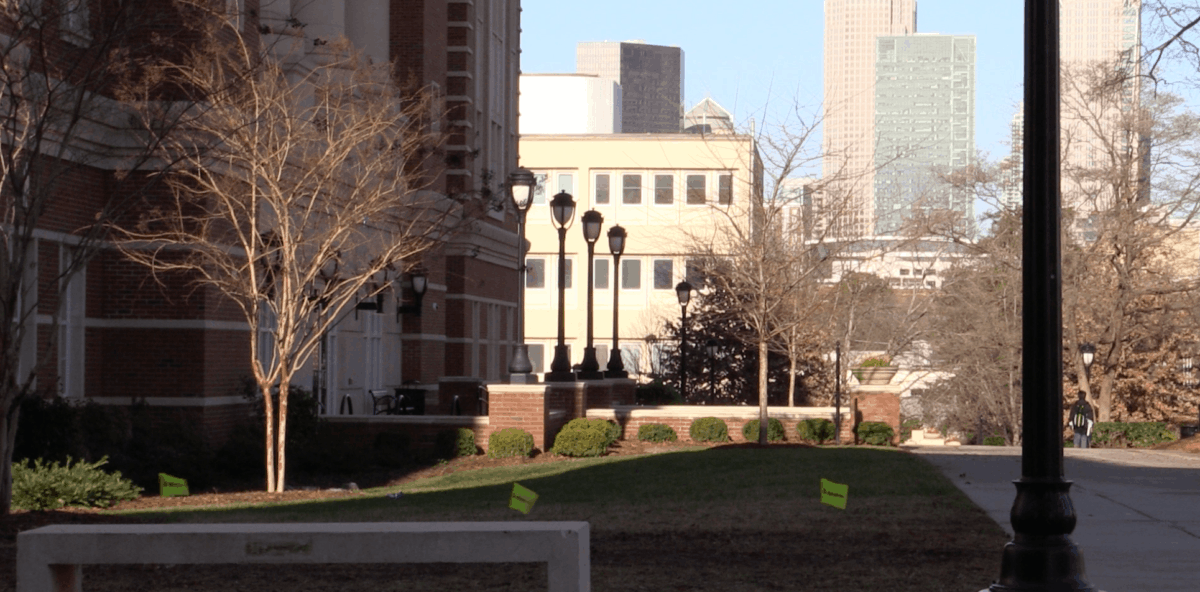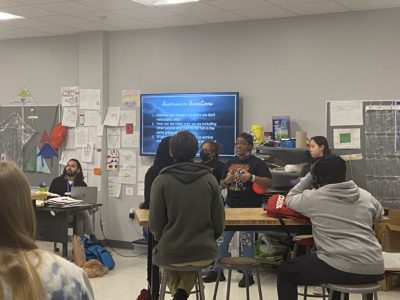Meet Mary. That isn’t her real name, but after years in an abusive marriage, she cannot afford to make it easy for her abuser to find her.
Mary fled from her ex-husband to live with her aunt in North Carolina. Afraid that her abuser would find her, she never got a driver’s license, filed for assistance through social services, or even signed a lease. She was careful not to do anything to establish herself in the system so she could remain in hiding.
Unfortunately, it became a threat to her ability to attend college.
After living in North Carolina for two years, she said, “You know, I have enough courage that I’m going to do something now. I’m going to invest in myself, because I’m worth it.”
But with no state records to prove her residency to qualify for in-state tuition, she needed a person to speak with and explain her situation. According to students like Mary, and the community colleges that serve them, that is not as easy to find today.
Mary, and others like her, are at the center of a growing issue with determining students’ residency status for community colleges in North Carolina. For years, cases like hers came directly to the local community college, and admissions personnel would work in-person, on a case-by-case basis to ascertain the right residency status. However, the process led to some inconsistent decisions and took up a considerable amount of staff time. So, last year, a new, centralized electronic system went into effect called the Residency Determination Service (RDS) aimed at making the determination process more efficient and consistent.
The system is used for all institutions of higher learning, including the UNC System. And while RDS seems largely to have worked as planned at the four-year universities, community colleges say it lacks the personalization and humanity necessary to address the individual and unique circumstances of their students and has become a barrier to people pursuing continuing education.
For its part, those who designed and implement RDS feel that RDS is misunderstood — and perhaps the target of blame more aptly directed at state laws.
This is a story about all of these stakeholders: students looking for better lives through further education, community colleges on a mission to provide access to continued learning, a residency determination system striving to apply state law, and a state that has an interest in ensuring residents enjoy the benefits of lower tuition subsidized by its tax payers.
In part two of this series, we will explore experiences of students and community colleges with RDS. Part three of this series examines RDS, tracing it from its birth and talking to the people who gave life to the machine. In part four, we will cover a legislative solution for which the community college system is advocating, aimed at addressing the biggest road block the new system has uncovered. Part five looks at alternative solutions floated by those on the front lines.
But what’s the fuss? Why does residency determination exist and why does it matter? Well, that’s where our series begins.

North Carolina was among the leaders in identifying the importance of education for its residents. The state’s first constitution provided for education to North Carolinians long before federal laws promised the same across the nation. And in drafting successor constitutions, the state determined that the benefits of public institutions of higher learning should be offered to the “people of the State” free of expense, as far as practical.
That promise has resulted in North Carolina consistently appearing among lists of best values for in-state higher education. According to a survey by The College Board, North Carolina’s average in-state tuition is the sixth lowest in the country.
State officials say this is made possible by significant subsidy through tax payer dollars. In fact, a study of funding for community colleges across the nation from 2000 showed that North Carolina taxes at one point funded 75 percent of community college budgets — the highest percentage of any state in the nation at the time.
With so much attention to using tax-payer money, the state has a significant interest in reserving lower tuition for so-called “people of the State.”
In-state tuition for one year of community college, on average, is about $2,400 in North Carolina, while out-of-state tuition is $8,500 — a remarkable and sometimes game-changing benefit to residents.

In order to protect the benefit for those intended, the state legislature enacted laws to determine whether a student is a North Carolina resident.
The “Provisions for determining residency status for tuition purposes” at postsecondary institutions were first written in the 1970s. To qualify as in-state, students must show they have established legal residence in North Carolina. The law defines legal residence as establishing “domicile” in the state. The applicant must maintain domicile for at least 12 consecutive months before the start of the school term and intend to make North Carolina their residence indefinitely (rather than being in the state just to attend college).
Importantly, the law states that if an applicant has living parents or a court-appointed guardian, then the applicant is assumed to live with them unless proven otherwise. This assumption may mostly hold true for those applying to UNC schools, but it can create a barrier for community college students, who are often older and financially independent, if they are asked to track down parental information.
For years, residency determination pursuant to this law occurred at the various campuses. Along with applications to a particular institution, students would fill out residency forms designed by that institution to ascertain their eligibility for in-state benefits.
Many of these applications focused on three primary factors of the law: Are you a resident of North Carolina? Have you been a resident for the last 12 consecutive months? And did you graduate from a North Carolina high school?
“I found out, historically, we used to ask just three questions,” said Isothermal Community College President Walter Dalton, citing the three above. “Those were the three questions. And we could use that, along with the other information we gathered, and make a determination.”
Dalton, and others using a similar process, were careful to point out that colleges were verifying this information. Sandy Lackner, a dean of students at Isothermal, described the verification process at her previous institution, Wilson Community College:
“It’s not just that everybody puts a ‘yes’ and everybody who lists ‘yes’ is a resident,” Lackner said. “We use common sense with it.”
They would review previous listed addresses, previous schools, driver’s licenses, electric bills, and lease agreements.
“We did what it took to make sure the process that we had in place here was followed,” said Tri-County President Donna Tipton-Rogers.
And if something seemed amiss, the colleges conducted further review.
“If you see they just graduated from a school in Virginia, that would raise a red flag,” added Amy Galla, who works with students obtaining high school equivalency education and helps them transition to postsecondary education. “How are you a North Carolina resident and you just finished high school in Virginia? That was a common catch of residency for students, as if they had been going to school in another state and for some reason wanted to come to college in North Carolina.”
In those cases, the school would take a closer look and ask for more evidence.
“So it wasn’t that we weren’t doing due diligence at a local level,” Lackner said. “But now it’s been taken out of our hands.”

Many lawmakers would admit, perhaps behind closed doors, that there was not a single catalyst for moving residency determination out of the hands of individual schools. After all, there was a lot going on at that time. In response to the creation of Deferred Action for Childhood Arrivals (DACA), the State Board of Community Colleges and UNC System schools attorneys stated that DACA students could attend postsecondary schools but were not eligible for in-state tuition because of the residency law.
Around the same time, the General Assembly’s program evaluation committee commissioned a study to examine inefficiencies in the UNC System and its 16 universities. The study found the system could be more effective by centralizing residency determination instead of having each campus conduct their own process.
Amid these conversation-starters in the background, there arose one clear rallying point — Hayleigh Perez.
A veteran who spent more than a year in Iraq, Perez wanted to take advantage of the GI Bill, which would pay her tuition at any school so long as she was in-state. After moving to Texas where her husband was stationed, she returned to Raeford, where she had continued to pay a mortgage and taxes, and started applying for a master’s degree. Fayetteville State deemed her a resident of North Carolina, but UNC Pembroke did not. Perez sued, claiming that the inconsistent application of residency laws was unjust and discriminatory.
When her story broke, it was embarrassing — and the first time the public realized how localized the residency decision-making was. Along with the news story, there were reports of at least one campus where residency determinations were made by any of dozens of people, according to the State Education Assistance Authority’s (SEAA) executive director Elizabeth McDuffie. This fueled concerns, not only of receiving conflicting residency determinations from one school to the next, but also within a single school.
“The statute was applied inconsistently,” McDuffie said. “The schools did ask their own questions and made determinations from those. Some asked many questions in trying to get to the preponderance of the evidence of residency, and others asked three. And then we would end up with inconsistent outcomes. The inconsistent application is partly why we ended up where we did, to centralize this process.”
Students had caught onto the inconsistencies and in some cases were trying to take advantage of them. If they received an out-of-state determination at one community college, they would go to the next one and try again. Sometimes, like at Central Piedmont Community College where there are six campuses, they would try more than once at the same school.
“I did see students campus hop,” said Joyce Crager, an admissions specialist at Central Piedmont. “They’d get a determination from me, they didn’t like it, so they’d go to another one of our campuses. Well, that looks bad.”
Central Piedmont is among a minority of community colleges which, though wanting to see the residency laws change, do not want to see RDS go away. Like the UNC System schools, which process hundreds of thousands of applications a year, Central Piedmont draws thousands from the heavily-populated Charlotte area, and the old system put a heavy burden on its personnel.
“They were coming in all the time,” Crager said. “They would bring one document that we’d ask them to, and we’d tell them we need two other documents, and they’d come back in and bring one more document. They’d be back three or four times doing that and you’re seeing the same student over and over again because they’re not writing down what they’re supposed to bring in. Now, it’s right there for you on the screen.”

Rather than separate out issues specific to four-year university students and community college students, the state searched for a common solution. In 2013, the General Assembly commissioned a study into centralizing and standardizing the process.
Lawmakers turned to the SEAA to lead the charge in finding a solution, and the SEAA in turn worked closely with a group including representatives from the UNC System, community colleges, independent schools and SEAA’s agent, College Foundation, Inc. (CFI).
Upon completion of the study, the legislature passed a law in 2015 entitled Centralized Process to Determine Residency for Tuition Purposes.
The goal was to take all of the various campus residency interview processes and create one online interview that dependably follows the residency statute. In designing and implementing the solution, SEAA and the working group of collaborators used CFI because CFI was already implementing similar software solutions for financial aid applications. In 2016, RDS was approved and implemented across all higher education institutions in 2017.
When the system was unveiled, it was billed as a way for students to “apply today, use RDS today, and have ‘classification’ for residency in ‘near real-time.’” The most promising notion: Ask the fewest questions necessary to arrive at a determination for in-state residency, but ask as many questions as necessary before determining out-of-state.
“It’s designed to try to ask the minimum number of questions to figure out that you are a resident,” McDuffie said, “and not ask anything anymore.”
To be fair, the system appeared easy enough to navigate for this reporter. At 40 years of age, born at old Rex Hospital, schooled in Wake County through high school, and the recipient of a law degree, the process took less than 10 minutes — an example of what the system can do under the best circumstance.

Other examples, however, have drawn frustration from both prospective students and community colleges. These include people who are fleeing unsuitable homes with parents in other states, people escaping abusive homes in other states, and many who have lived in the state for years but could not be confirmed as residents because of intricacies in the law.
For many we spoke to, the process took hours or more. In fact, some community colleges reported students using campus computers for RDS and returning for several days trying to get through the process.
“Some people might get asked a lot more questions,” McDuffie acknowledged, “because if he starts answering things like, ‘My parents live in South Carolina,’ well then we’re going to start presenting a few more questions to start to try to figure out what’s the affiliation to North Carolina and how can we find out that you are a resident of North Carolina.”
These students, and others in similar circumstances, will be asked for parental information within the first few pages, including address, tax information, and social security numbers — a byproduct of the law’s assumption that students live with their parents.
But the law doesn’t easily account for circumstances where students are estranged from their parents or have reached adulthood and are no longer living with their parents.
“A lot of it was really focused around lifestyles of students who may be experiencing a little bit more secure family situations, at least with housing,” said Lackner, who participated in conversations and information sessions about RDS from its inception.
Unable to furnish personal information about their parents, thousands of prospective community college students who started the RDS process abandoned their applications. Amid several such reports from various schools, the community college system commissioned a study to identify what was happening and found that 40 percent of the applicants who dropped off of the RDS did so during questioning about their parents.
Others experienced trouble because they found the questions confusing, and once one errant response was recorded, they were sent down a line of questioning not applicable to them. Some were frustrated because they couldn’t explain to the computer that while they lived in this state for more than a year, their situation required personal explanation.
Dalton thinks back to when it was just three questions and notes his first impression when he went to try the new RDS system: “There’s a [tab] called ‘Resources,’ and if you go there the first thing it says is the ‘10 things you need to know about RDS,’” he said. “We used to have three questions, and now you need to know 10 things before you even start the process. That’s enough of a barrier right there.”
According to RDS, there is one-on-one interviewing offered through the new system. The first time a student moves through RDS, the process is intended to be one-way communication to efficiently collect information and weed out the standard cases. However, RDS is designed to provide special cases more attention later. For instance, it gives an applicant 10 days to appeal out-of-state determination, at which point it will schedule a telephone or in-person meeting. There is also a second appeal available, where the case will be sent directly to SEAA for review.
But community college officials believe starting with the computer and requiring appeal before having in-person communication does not work for their prospective students.
“At the university system, it works,” Tipton-Rogers said. “Those students plan ahead. They know where they’re applying months, if not a year, ahead of time. They have deadlines, they know what the cut-off dates are. It just doesn’t work that way with the community college system.”
“RDS is detrimental to the mission of the community college system,” Tipton-Rogers continued. “The system is built on the principle to take people where they are and carry them as far as they can go. But RDS has been a road block for us. It’s not the one-size fits all program that many thought that it would be when it was developed. Clearly, it hinders the philosophy that’s at the heart of the community college system and our students are suffering, I think, because of it.”
Part two of the series, released tomorrow, will look more in-depth at student and staff experiences with RDS.
Correction: A previous edition of this post incorrectly stated 40 percent of applicants dropped off the RDS during questioning about their parents. It is 40 percent of the applicants who dropped off of the RDS did so during questioning about their parents.
Recommended reading




